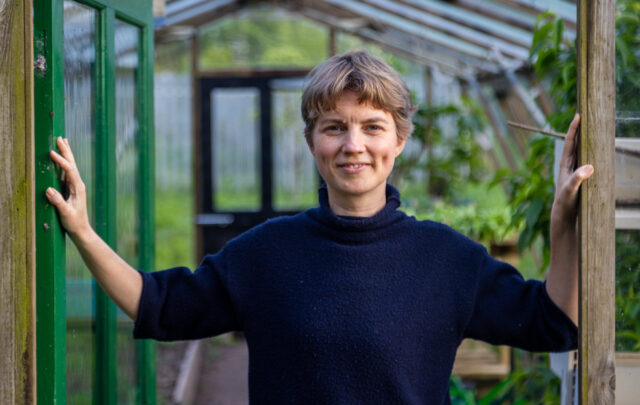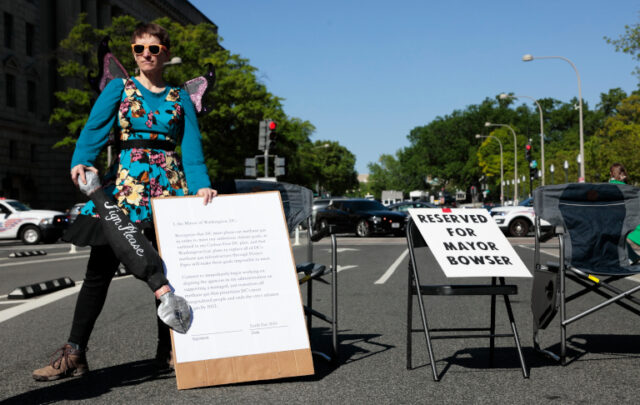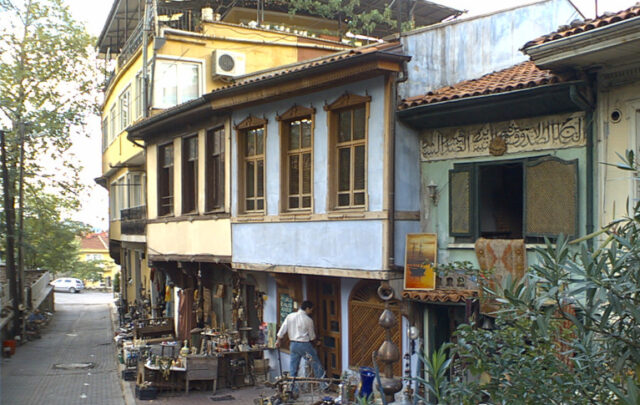I do an audience analysis exercise in my freshman composition classes at community college. As part of it, students have to compose questions about their topic for their classmates, to determine how people feel about it, how familiar it is, and what people already know. I join in, since I’m always writing something myself, and since it’s interesting to hear what students are thinking. Generally my questions are about subjects like peak oil, future technologies, and climate change. It is striking, though not conclusive, that over the past few years students’ answers have become increasingly pessimistic. They’ve gone from rocket cars and living on Mars to a future of pollution, sea level rise, and extinction.
In the most recent run-through, I asked first if they believed that climate change was a serious issue. All of them said yes, it was – a significant increase from five years ago. Then I asked if they expected that climate change would affect them personally. Only one said yes, and he was tentative about it. Others said they thought maybe their grandchildren would feel the effects, but they didn’t see any ways in which their daily lives would change.
I suspect that part of the reason for the dissonance between the two responses was that almost all thought of sea level rise as the chief threat of climate change – and since Indiana is hundreds of miles from the sea, they would not themselves be forced to move or face floods. They did also mention that temperatures seemed to be getting hotter, but in itself that didn’t seem too severe a problem.
These young adults are good people, thoughtful and caring about the future. But they display some gaps in understanding that I suspect may be typical of many, not just college students. So I hope they don’t mind, but I will use them to address the question that they and all of us should be asking: How exactly will the swirling chaos that is climate change affect us, even Hoosiers living in the middle of a continent? The subject is complicated enough that I can’t make any absolute claims about a one-to-one correspondence between increased greenhouse gases in the atmosphere and all the problems I see, but I think the case can be made for the role of climate change in all of them. I am writing about Indiana specifically, but my points can apply to a variety of places.
It does seem to be getting hotter, students said. Well, Indiana so far has not seen as dramatic increases in average temperature as the polar regions have, so their perception is just that summer lasts a bit longer and we’re maybe less likely to get a good sledding day during the winter. It takes more intellectual effort to remember that this spring, much of the Midwest flooded, and farmers planted their crops late or not at all. The anticipated yield of corn and soybeans, Indiana’s chief crops, is down for 2019. My students live in a farming community, even if they themselves don’t farm; they can’t help but be affected. When yields are down, farm land gets abandoned or sold to wealthy investors, loans from local banks are defaulted on, and/or families move out and leave communities increasingly smaller and less able to support amenities such as grocery stores, pharmacies, hospitals, and restaurants. If that continues to happen, my students will have to drive farther and farther for what they need, spending more on gas and wearing down infrastructure that is supported by fewer tax dollars.
But going back to the weather. While much more data need to be collected, it seems as if the biggest change happening in Indiana is not weather temperature so much as weather pattern. In the last ten years, in addition to this year’s spring flooding, we had a blizzard in 2009 that lasted an extraordinary period and led to gas companies running out and people not being able to heat their homes (We had a wood stove, but even with it the house was in the 30s when we got up in the morning); an ice storm that kept parts of the state inside for more than a week in 2011 (which we again spent around that wonderful wood stove); and a drought in 2012 rated worse than anything since the Dust Bowl (in which one of our goats died). I heard speculation in each case that the weather was aggravated by shifts in the Jet Stream that caused weather patterns to stall. Indiana has always had severe weather, but it’s been changeable: thunderstorms, tornadoes, and blizzards used to give way to milder weather within a few days. That may no longer be the norm.
And while severe weather is bad, the most pressing issue is not just the severity but the unpredictability. Hoosier farmers could grow rice if they knew that weather would be hotter and wetter; but if every year is different, and every season varies wildly, how can they know what to plant? In recent years over 60 percent of land in Indiana has been devoted to agriculture or forestry, and income from it has accounted for about five percent of Indiana’s economy. Farmers not being able to farm would affect not only individual families but the whole state where my students live – tax revenues, employment, manufacturing, banking, and many other sectors would feel the loss.
Climate change is also one driver behind immigration and refugee issues. Environmental degradation, change in growing zones, and health and productivity impacts of extreme heat are propelling migrants northward from Mexico and Central America. Yes, they have political problems in their home countries, too – but some at least of their political problems can be traced back to the unrest caused by climate change. And even within our own country, we can expect to have more people displaced by sea level rise heading for places like Indiana that have land. (We still have a Louisiana diaspora that settled here after Hurricane Katrina.)
On the whole, immigration has been a boon to Indiana, and Hoosiers are fine with it. But if the economy shrinks as farmers take hit after hit from unpredictable weather, there might come a time when my students have to compete for jobs with people different from them. We are already beginning to see the unrest caused by this situation in other states. Job competition and a contracting economy don’t look like climate change on the surface – and there are, of course, many other partial causes for them – but there is no denying that the winds of climate change are pushing migrations around the globe.
And whenever new people arrive from foreign places, they risk introducing their own endemic or newly evolving diseases into a place that isn’t resistant to them. Much of human history has been driven by the impacts of new diseases as people expand over new territory , and we can’t expect that to stop. New diseases are also much more likely to evolve where people are packed closely together without proper sanitation and health care – conditions that are descriptive of every refugee encampment and impoverished neighborhood where immigrants might find themselves.
In addition to increased travel of vulnerable people, other conditions suggest that Indiana may see more and different diseases in the future. Insect vectors that previously were unable to survive here may soon be able to, as the climate warms. Warmer conditions always benefit germs over people, which is why the tropical regions of the world are known for the number and variety of infectious agents that thrive there. New illnesses enabled by a changing environment will affect animals and plants as well as humans, and Indiana’s whole ecosystem will not be immune to the threat. When my students said that they didn’t believe that climate change would affect them personally, they were not thinking about dengue fever or malaria. (Indiana used to have malaria, as did much of the United States; it was public health as much as climate zones that eradicated it. But if a perfect storm of economic, political, and climactic threats reduces Indiana’s ability to mount public health campaigns, what will happen then?)
These issues won’t affect Indiana alone. Our state currently gets 31% of its yearly income from the federal government one way or another. If the federal government is devoting more and more of its revenue to paying flood insurance and crop insurance, repairing essential infrastructure such as harbors, airports, roads, train tracks, and the electric grid, as well as relocating displaced people, how much of that 31% will or even can continue to support us here? Given the high profile of the places most likely to experience disasters – New York City, Miami, New Orleans, Houston – can Indiana really hope to compete with them? So whether my students realize it or not, they can’t avoid the economic impact of climate change, even if they’re safe from sea level rise.
But we don’t need to look to the future to anticipate effects; they’re happening right now. I mean today. As I am working on this article, I hear from my husband that his conference has been canceled and he is stuck in California until he can change his flight home to Indiana. The conference, meeting at the University of California at Berkeley, is expecting shutdowns of electricity, deliberately scheduled by Pacific Gas and Electric to reduce the risk of wildfires in the current hot, dry weather. The increasingly dangerous conditions in California have been partially attributed to climate change by more than one report. Fortunately, this time my husband’s employer will pay for the travel expenses, but eventually many people will feel the cost of unpredictable work, travel, and energy. (Of course, my husband’s employer is a university here in Indiana, which will eventually have to pass increased costs of doing business to its students.)
So the ideal, obviously, is to change our behavior drastically enough to slow and eventually stop the unfolding disaster. While my students don’t really expect that humankind will be that sensible, they think it would be nice if we were. I agree; that would be a consummation devoutly to be wished. But would the necessary reconfiguring of society enable my students to live unaffected by climate change? I don’t think they realize that if the best-case scenario plays out, their lives would be changed even more immediately and thoroughly by our doing the right thing than they will by our drifting aimlessly towards irreversible, planet-wide damage.
Here’s what I mean. If we decided tomorrow to address our problems, we would need to do thousands of things to cut greenhouse gas emissions. We’d have to stop burning fossil fuels – in cars, electric plants, hospitals, houses, radio and cell towers, manufacturing, every aspect of our lives. That means fewer consumer goods by several orders of magnitude, since the manufacturing, shipping, and selling would all be curtailed. We’d have less stuff. We’d cut back on plastics, since they are mostly made of fossil fuels and obviously involve manufacturing and transport. Not just plastic bags, bottles, and straws, but fleece sweaters and blankets, medical devices and supplies like syringes and blood transfusion bags, mechanical pencils, ballpoint pens, and a million other things that we take for granted would be scrapped. And most of the people who worked in all the industries making, shipping, warehousing, selling, repairing, and using all these products would have to find a different job – and there would have to be different jobs for them to find.
in addition, houses would be smaller and colder in winter and hotter in summer. Sensible communities might establish siestas during the summers, so the work week would look different. We’d eat less meat; in fact, we’d eat a lot less food in general. Our employment, education, and recreation would change if we couldn’t drive our own cars and had to rely on the level of public transportation that could be managed without the power of fossil fuels. Our neighborhoods would look different. What we spent our money on would change. And these are just a random sample of the overarching adjustments we’d have to make. Truly, my students’ lives would be unimaginably altered.
They would probably argue here that alternative energy will fill the gap and enable them to go on living as they have been. But that’s a vain hope. While solar, wind, and other renewable energy sources are wonderful, they don’t pack the concentrated energy punch that millions of years of stored sunshine does. We also haven’t found a practical way of manufacturing alternative energy infrastructure without using fossil fuels. The kinds of windmills and solar panels we use now are a transitional technology that will have to be changed in the future, when fossil fuels are exhausted. There’s no way around it: the life that wealthy nations have lived in the last century will be gone with the wind – and the flood, heat wave, drought, and other extreme weather event.
So yes, whether we do the right things or keep doing the wrong things, whether our current systems collapse or are carefully dismantled and rebuilt, even young Hoosiers leading modest lives in a small town in western Indiana will be personally affected by climate change. I am sorry, guys. And you still have to turn in your homework.





